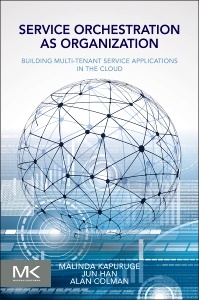Service Orchestration as Organization Building Multi-Tenant Service Applications in the Cloud
Auteurs : Kapuruge Malinda, Han Jun, Colman Alan

Service orchestration techniques combine the benefits of Service Oriented Architecture (SOA) and Business Process Management (BPM) to compose and coordinate distributed software services. On the other hand, Software-as-a-Service (SaaS) is gaining popularity as a software delivery model through cloud platforms due to the many benefits to software vendors, as well as their customers. Multi-tenancy, which refers to the sharing of a single application instance across multiple customers or user groups (called tenants), is an essential characteristic of the SaaS model.
Written in an easy to follow style with discussions supported by real-world examples, Service Orchestration as Organization introduces a novel approach with associated language, framework, and tool support to show how service orchestration techniques can be used to engineer and deploy SaaS applications.
Jun Han received his PhD degree in Computer Science from the University of Queensland (Brisbane, Australia) in
1992. Since 2003, he has been Professor of Software Engineering at Swinburne University of Technology
(Melbourne, Australia). His primary research focus has been the architecture and qualities of software systems. His
current research interests include dynamic software architectures, context-aware software systems, cloud and
service oriented software systems, software architecture design, and software performance and security. He has
published over 200 peer reviewed articles in international journals and conferences.
Alan Colman Han received his PhD degree in Computer Science and Software Engineering from Swinburne University of Technology (Melbourne Australia) in 2006. Since 2006, he has been a researcher and senior lecturer in Software Engineering at Swinburne University of Technology (Melbourne, Australia). His primary research focus has been adaptive service oriented software systems, context-aware software systems, software and cloud performance prediction and control. He has published over 70 peer reviewed articles in international journals and conferences.
- Describes the benefits as well as the challenges of building adaptive, multi-tenant software service applications using service-orchestration techniques
- Provides a thorough synopsis of the current state of the art, including the advantages and drawbacks of the adaptation techniques available
- Describes in detail how the underlying framework of the new approach has been implemented using available technologies, such as business rules engines and web services
Date de parution : 08-2014
Ouvrage de 334 p.
15x22.8 cm
Thèmes de Service Orchestration as Organization :
Mots-clés :
Adaptability; Adaptation patterns; Adaptation phases; Analysis; Aspects; Axis2; BPEL; BPM; Behaviour modelling; Business constraints; Business requirement; Business rule integration; Business rules; Business services; Case study; Cloud computing; Contracts; Drools; EPC; Eclipse; Evaluation; Event cloud; Event-driven; Extensibility; Flexibility; Multi-tenancy; Orchestration; Organization; Performance; Process life cycle; ROAD4WS; Recursive design; Results; Road-side assistance; SLA; SOA; SaaS; Scheduling; Scripting; Serendip Language; Serendip framework; Serendip runtime; Service composite; Service proxy; Specialization; Templates; Tools; Validation; Variability; Web services; XSLT


